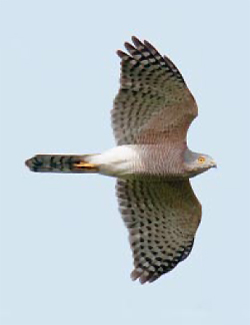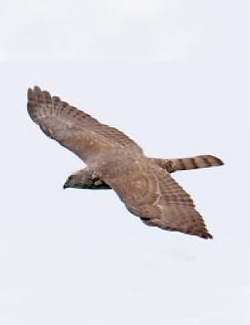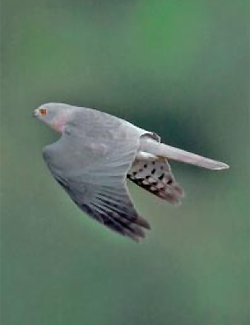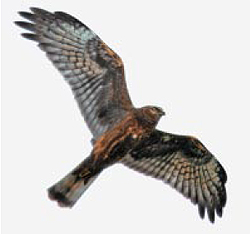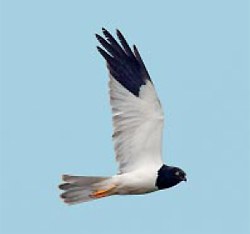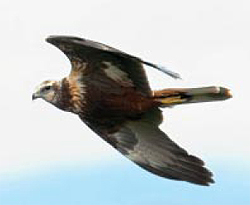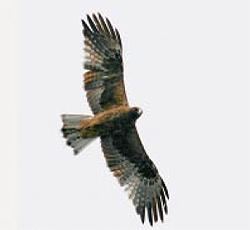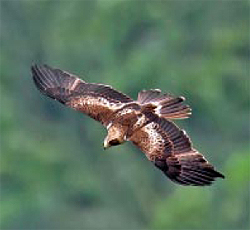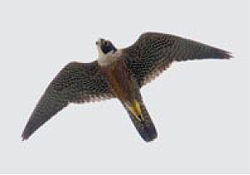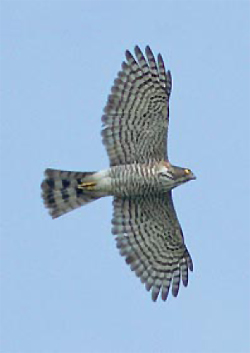
|
||||||||||
|
||||||||||
| Favorite Tweets by @thaibirding | ||||||||||
|
||||||||||
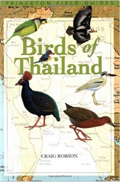 Buy Birds of Thailand on Amazon.co.uk |
||||||||||
| Site Map ; Contributors |
| Khao
Dinsor, Thailand: the premier site to observe migrating raptors in
the Orient? By Chukiat Nualsri and Robert DeCandido |
|||||||||||
Tweet
 |
|||||||||||
| Note:
This article was originally published in Birding Asia 14 (2010), the
bulletin of the Oriental
Bird Club, and was kindly submitted by Robert DeCandido. Please support the OBC's conservation work by visiting the OBC website and becoming a member. |
|||||||||||
|
About the Adverts |
|||||||||||
| In
September 2008, CN learned of a 450 m hill where raptors could be
observed in southbound migration from August to mid-November every
year. Locally it is called Khao Dinsor (Pencil Hill) (10.63°N
99.28°E) and it lies close to the city of Chumphon. One morning,
after slowly making his way up and through the second-growth forest,
CN finally emerged atop the tall hill—the view was spectacular
with the Gulf of Thailand to the east and the Isthmus of Kra to the
west (Plate 1). It quickly became apparent that migrating raptors
could indeed be observed at close range from many different locations
on Khao Dinsor. On subsequent visits, CN had the same experience—many
raptors of different species migrating close to the ridge. In September 2009, a number of us from the Thai Raptor Group joined CN to climb Khao Dinsor and watch the migrants. All of us are now in agreement that the hill is the best place to observe raptors on migration in Thailand, if not all of Asia. As an added bonus, the light is at your back for most of the day, making birds easy to photograph. We also observed other species heading south including three bee-eater species, Black Drongo Dicrurus macrocercus, flocks of Ashy Minivet Pericrocotus divaricatus, Dollarbird Eurystomus orientalis and, once, a pair of Wreathed Hornbills Aceros undulatus. Much more remains to be discovered here about southbound bird migration by both day and night. Once CN realised the significance of Khao Dinsor, he approached the village elders to discuss how to develop the site for education, tourism and bird migration research. Together they developed a plan and in just three months, with major funding from Governor Karan Supakitvilekakarn of Chumphon Province, a 1.5 m wide path was built through the forest to the best observation sites on the ridge. Some of these feature wooden shelters for protection from the rain and sun, and a paved road was constructed from the main road to a level area at 200 m. This will become the site of the future Chumphon Raptor Education and Research Centre, for which significant funds have already been budgeted. Here, in the coming years as part of our educational programme, we plan to show the public some of the migrants that we will trap and ring at Khao Dinsor. We are currently in discussions to form research and educational partnerships with international organisations including the Hawk Mountain Sanctuary of North America, a premier raptor migration research non-governmental organisation. As a first step, they have offered to train Thai students and others. We are also in discussions with BirdLife International to have Khao Dinsor declared an Important Bird Area. Closer to home, we will be partnering with the Bird Conservation Society of Thailand to develop an educational programme about birds and the environment for the people of Chumphon province. We are also interested in partnering with other international organisations—do contact us for more information at Thai Raptor Group |
|||||||||||
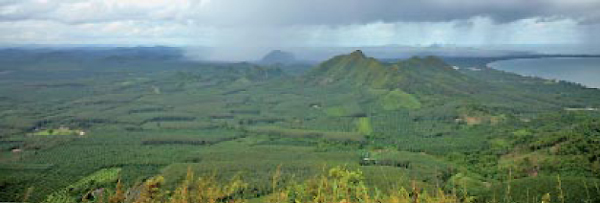 Plate 1. Khao Dinsor looking north with Gulf of Thailand to the east. (Photo by Robert DeCandido) |
|||||||||||
| From early September 2010, we began an intensive research programme at Khao Dinsor to determine how many raptor species and others migrate past the site, and in what numbers. Based upon preliminary observations, we estimate that the southbound autumn migration may be between 250,000 and 500,000 raptors of at least 25 species, including five Accipiter species—the highest number of Accipiter species at any watch site in the world. On 18 October 2010, a Black Eagle Ictinaetus malayensis malayensis was photographed at Khao Dinsor; this bird followed the same track as the migrants that day—arriving low from the north and continuing to the south— possibly the first record of this species on migration in Thailand, although it may have wandered from the mountains that separate Thailand from Myanmar. There are other exciting possibilities, as we have already seen White-throated Needletail Hirundapus caudacutus, once thought to be rare in Thailand, pass by in flocks of 30–40 birds. | |||||||||||
|
|||||||||||
| If you wish to help support our ongoing education, conservation and research programme at Khao Dinsor, please visit the site to watch the migration and photograph the birds. The best time is from mid-September to early November with the peak being from about 10–30 October. The sheer numbers of migrants and their close proximity to the hill makes for an extraordinary spectacle. For best viewing, visitors should remain as still as possible because we have observed that migrants veer away from the hill if there is too much movement on the ground. By spending money on hotels and restaurants in the area, you demonstrate that the investment made by the government in Khao Dinsor was worthwhile—and help advance the cause of conservation and bird migration research in Thailand. | |||||||||||
|
|||||||||||
| Directions
to Khao Dinsor from Highway 4 Khao Dinsor is near the town of Pathiu (Pathio), approximately 25 km north-east of Chumphon. Khao Dinsor may be accessed from the main north– south road, Highway 4 (Petchkasem Highway or the King’s Highway). Find the Tha Sae junction to the north of Chumphon and turn onto the well-marked road 3180. Travel towards the coast on this road for 15 km until you reach the sign for ‘Pathio, Chumphon Airport’ and turn left onto the 3201; follow the 3201 for 5 km. A large wat (temple) on the left is the landmark for the Dinsor Hill about 500 m beyond. The Khao Dinsor sign is on the left with an access road which twists and turns up the hill for roughly 2 km to a large car park. You may park here or drive for another 150 m until the road ends—it is possible to park here as well. Nearby, a narrow concrete trail leads into the forest. It is a 45-minute walk to the top, although there are a number of observation points along the trail, some of which have wooden shelters that provide protection from sun and rain. Remember to bring water and sunscreen. Please take away all your garbage—there are no receptacles (and no toilet facilities) along the trail. |
|||||||||||
| Acknowledgements Many people have worked together to bring the Chumphon Raptor Centre closer to reality, including Pathiu District Sheriff, Somsak Chareonpaitoon; village headman Jareak Kosin and his assistant, Chonggod Boonyapijit; and Community Chairman Wichai Skulthatanit, and we especially wish to acknowledge the leadership role played by Governor Karan Supakitvilekakarn and his wife, Mrs Panit Supakitvilekakarn. Our sincere thanks also go to Chaiyan Kasorndorkbua of Kasetsart University, Keith Bildstein of the Hawk Mountain Sanctuary in North America, Mike Crosby of BirdLife International, Damian Smith, Nurak Isarasena and Edmund Pease, Jean Marc Thiollay, Philip Round, Martti Siponen and Corry Chen. Our research in Thailand was made possible thanks to the strong support from our families and friends including Aree Nualsri and son, Narathip, as well as Deborah Allen. |
|||||||||||
|
|||||||||||
| Kindly
submitted by: Robert DeCandido, 1831 Fowler Avenue, The Bronx, New York 10462, USA. Email: rdcny@earthlink.net Chukiat Nualsri, Nathung Administrative Organization, 99 Mu3 Nathung sub-District, Muang Chumphon, 86000 Thailand Email: bnternstar@gmail.com |
|||||||||||
Tweet
 |
|||||||||||

A Guide to Birdwatching in Thailand. Copyright © 2004-2017 thaibirding.com. All rights reserved.
